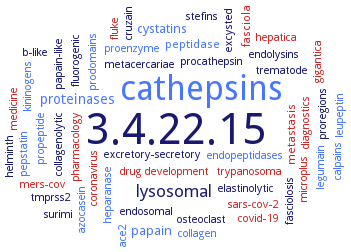3.4.22.15: cathepsin L
This is an abbreviated version!
For detailed information about cathepsin L, go to the full flat file.
Reaction
similar to that of papain. As compared to cathepsin B, cathepsin L exhibits higher activity towards protein substrates, but has little activity on Z-Arg-Arg-NHMec, and no peptidyl-dipeptidase activity
=
Synonyms
AgCatL, Aldrichina grahami cysteine proteinase, cat L, Cat L-A, Cath L, cath-L, cathepsin L, cathepsin L isoform CRA-b, cathepsin L-A, cathepsin L-A1, cathepsin L-A2, cathepsin L-A3, cathepsin L-B, cathepsin L-like, cathepsin L-like cysteine protease, cathepsin L-like enzyme, cathepsin L-like protease, cathepsin L-like protein, cathepsin L-like proteinase, cathepsin L-like rCPB2.8, cathepsin L1, cathepsin L1H, cathepsin L3, cathepsin-L, cathepsin-L T2V, CathL, CatL, CATL A IV, CATL-1, CATL-2, CatL1G, CatL1H, CatL5, CL1, CL3, CL41.5, CPL, cpl-1, CsCPL, CsCPL-m, CtL, CTSL, CTSL1, CTSL2, Cwp84, FhCL1, FhCL3, Har-CatL, human cathepsin L, major excreted protein, MEP, PDP, progesterone-dependent protein, rhodesain, SMCL1, SoCatL, sperm-histone protease, TsolCL
ECTree
Purification
Purification on EC 3.4.22.15 - cathepsin L
Please wait a moment until all data is loaded. This message will disappear when all data is loaded.
Please wait a moment until the data is sorted. This message will disappear when the data is sorted.
ammonium sulfate precipitation, column chromatography, Toyopearl HW-55 F gel filtration
-
ammonium sulfate precipitation, DEAE-Sephacel gel filtration, Sephacryl S-100 gel filtration, SP Sepharose fast flow chromatography, and Con A Sepharose chromatography
-
ammonium sulfate precipitation, Phenyl-Sepharose column chromatography, and SP-Sepharose column chromatography
butyl-Sepharose column chromatography
-
cathepsin L exists in Chinese hamster ovary cell culture fluids obtained from cell lines expressing different products and cleaves a variety of recombinant proteins including monoclonal antibodies, antibody fragments, bispecific antibodies, and fusion proteins. Product fragmentation is caused by copurification of the cysteine protease, Cathepsin L. Therefore, characterization its chromatographic behavior is essential to ensure robust manufacturing and sufficient shelf life. The chromatographic behaviors of Cathepsin L using a variety of techniques including affinity, cation exchange, anion exchange, and mixed mode chromatography are systematically evaluated. Copurification of cathepsin L on nonaffinity modalities is principally because of similar retention on the stationary phase and not through interactions with product. Cathespin L exhibits a broad elution profile in cation exchange chromatography (CEX) likely because of its different forms. Affinity purification is free of fragmentation issue, making affinity capture the best mitigation of cathepsin L. When affinity purification is not feasible, a high pH wash on CEX can effectively remove cathepsin L but results in significant product loss, while anion exchange chromatography operates in flow-through mode does not efficiently remove cathepsin L. Mixed mode chromatography, using adsorption resin in this example, provides robust clearance over wide process parameter range (pH 7.7, 50 mM NaCl), making it an ideal technique to clear cathepsin L, method developent and evaluation, overview. Fragmentation does not occur at pH 7.0 at both 25°C and 37°C, suggesting that the protease is nearly inactive under neutral pH conditions. At pH 5.0 and pH 6.0, while the fragmentation is barely detectable at 25°C, it is pronounced at 37°C. The results suggest that the presence of the proteolytic activity under mildly acidic conditions (commonly used for formulation) still poses a significant threat to long-term product stability
CM Sepharose column chromatography
complex of cathepsin L and the MHC class II-associated invariant chain fragment from human kidney that has stabilizing and inhibitory effect
-
glutathione Sepharose column chromatography, and gel filtration
glutathione-Sepharose column chromatography
heparin-Sepharose chromatography
His Bind column chromatography
in a single-chain form and in a form of proteolytically active complexes with an endogenous cystatin
-
native enzyme is purified from the hepatopancreas by ammonium sulfate fractionation, cation exchange chromatography, and preparative gel filtration
Ni-NTA column chromatography
Ni-Sepharose 6 Fast Flow column, eluted with binding buffer containing 500 mM imidazole, activation of immature cathepsin L by dialysis, Sephadex-75 HR column, dialysis, blocked with 10-fold molar excess of methyl-methanethiosulfonate
Ni2+-NTA affinity column chromatography
Ni2+-NTA column chromatography, and gel filtration
nickel-chelating Sepharose column chromatography
-
nickel-chelating Sepharose column chromatography, gel filtration
-
partial purification by gel filtration
-
partial purification by Superdex-75 gel filtration
-
proteolytically active complex of the proteinase with an endogenous inhibitor of cysteine proteinases
-
recombinant extracellular enzyme partially from Hansenula polymorpha by ultrafiltration and dialysis
recombinant His-tagged wild-type and mutant enzymes from Escherichia coli strain BL21(DE3) by nickel affinity chromatography and ultrafiltration
recombinant refolded His6-tagged mature domain of CsCPL (CsCPL-m) from inclusion bodies of Escherichia coli
recombinant rhodesain from Pichia pastoris
Sephacryl S200 gel filtration and CM-Sephadex gel filtration
-
Sepharose 6B column chromatography
-
SP-Sepharose column chromatography, High S Cartridge column chromatography and Concanavalin A-Sepharose 4B affinity column chromatography
-
the enzyme binds to concanavalin A, but not to Lens culinaris agglutinin, Ricinus communis agglutinin 120 (RCA120), and wheat germ agglutinin
-

-
Ni-Sepharose 6 Fast Flow column, eluted with binding buffer containing 500 mM imidazole, activation of immature cathepsin L by dialysis, Sephadex-75 HR column, dialysis, blocked with 10-fold molar excess of methyl-methanethiosulfonate

Ni-Sepharose 6 Fast Flow column, eluted with binding buffer containing 500 mM imidazole, activation of immature cathepsin L by dialysis, Sephadex-75 HR column, dialysis, blocked with 10-fold molar excess of methyl-methanethiosulfonate




 results (
results ( results (
results ( top
top





